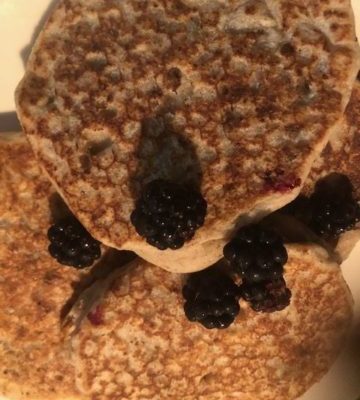If I had a dollar each time someone asked me about adjusting the cooking time for a recipe in the pressure cooker, I would probably be able to afford a nice cup of tea each week. (I have been asked this twice in the past few days which is what prompted this post.)

Me and my pressure cooker
Rest assured that even without those dollars, I do enjoy many nice cups of tea each week. Let me explain, though, about the cooking times in the pressure cooker and why you don’t have to change anything about the cooking time.
Let’s say that instead of cooking 1 cup of brown rice and adding 1 1/2 cups of water and cooking for 20 minutes, you want to cook 2 cups of brown rice. Using The Veggie Queen’s magic grain cooking algorithm you would add another cup of rice and 1 1/4 cups more liquid (of your choice). You would have 2 cups of rice and 2 3/4 cups of liquid. You lock the lid on the pressure cooker and wait for it to come to pressure and start timing for 20 or 22 minutes, according to how you like your rice cooked.
The pressure cooker will naturally take longer to get to pressure because there is more liquid in the pot. It will also take longer to do the “natural pressure release” because the pot will be hotter with the additional liquid. The time will not double but might increase by 20 to 30% depending upon what you are cooking and if you are doubling, tripling or making multiple servings of your dish.
The same principle applies when you cook beans, soup, chili, curry or any other dish in the pressure cooker. You just cook for the amount of time indicated in a recipe. The cooker does the work for you.
Isn’t this handy?
Whether you use a stove top or an electric pressure cooker, this is the case. This is just another reason that I love pressure cooking so much. It takes the work out of cooking. Rice takes 20 minutes at pressure even if you cook 4 cups, although some people say that I am trying to fool them with this statement. I am not.
Truth be told, it will take longer to cook 4 cups of rice than just 1 cup, but no matter what it will likely still take less time than cooking rice on the stove top. This is even more true for beans, which might take 1 hour on the stove top and just 8 minutes at pressure in the pressure cooker.
If you have any comments or any other pressure cooker questions, please feel free to leave them here. I love getting more people to use the pressure cooker. It changes lives…


I just stopped using recipes altogether.
I would like to make pressure cooker pork chops w smashed potatoes but the recipe only does 6 inch thick chops and i need to at least double this, would i have to double the liquid as well? Please help!!!!
Just received my PC…I cooked 1 cup of black beans (after doing the quick soak method for the beans). They came out perfect…all right success! So my next test was to try 2 cups of black beans soaking like before. This time they came out mush (guess I will turn them into “re fried” beans). What went wrong? They did take longer to come up to pressure and longer to release the pressure.
I live at 8,000 ft, have a Presto 6 qt stainless. Both batches of beans were from the same package. Any help would be appreciated!
Leslie,
I am wondering how much liquid you added to your beans when cooking them. If you use too much water you can end up with overcooked beans. I recommend 1/2 to 3/4 cup liquid for each dry cup of beans that you have soaked. Perhaps that was the problem. I hope so.
The last two times I’ve used my Instant Pot, I had something odd/wrong happen…. the first time I was cooking steel cut oats (a relatively small amount with an appropriate amount of water), and tonight I was cooking 3 cups of quinoa with 3 cups of water.
In both cases, the PC did not come up to pressure, and it acted as though the lid was not correctly closed…. steam was rushing out of it all around the edge of the lid! This has never happened before. In both cases I checked to ensure that the seal was in the sealed position, not the vent position. In both cases, I turned the whole thing off and waited for it to cool down on its own. I then carefully examined the gasket to see if it seemed damaged or out of position.
Nothing seemed off in any way that I could discern. Any ideas?
Did you check the gasket to see if it was seated correctly? This often the cause of issues like what you mention.
You have just a question that have been trying to find and answer to.Thank you very much.